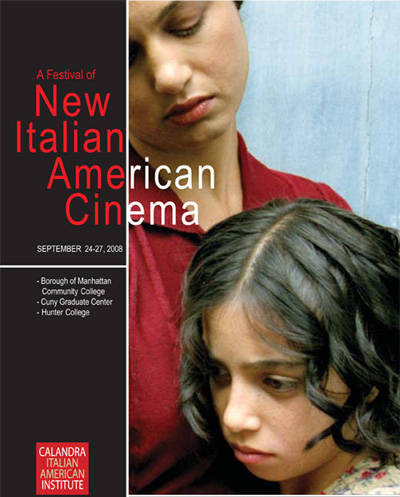A Festival of New Italian American Cinema Opens in New York
As one rehearses a history of Italians and Italian Americans in three major mediatic forms, what becomes apparent is that Italians and Italian Americans are by no means a lacking entity in cinema, music, or television; nor have they ever been, be it from the perspective of their actual presence or simply their mere representation in films portrayed by others. Be it Rudolph Valentino, Madonna, or Ezio Pinza, Italian Americans have had a conspicuous presence in the movies, in music videos, and on TV, even though, at times, debatable. Indeed, this debate rages on, and, while sympathetic to the cause of Italian anti-defamation, one might very well come to it from different view points.
 The possibility of a monolithic perspective is, to be sure, not the most constructive of manners to carry forward such a debate.
The possibility of a monolithic perspective is, to be sure, not the most constructive of manners to carry forward such a debate.
We may, therefore, indeed question some of the more popular “Italian/American” movies and TV shows that seem to populate both the large and small screens and enjoy, even among Italian Americans, a certain privilege among viewers. One need only think of Friends, a show whose Italian American is not the most ideal of models. A similar question mark might be raised about the ever popular Everybody Loves Raymond, in which mother and father, together with their two sons, might be seen to impute a certain amount of buffoonery and fesseria to Italian Americans.
One might indeed argue that the negative depiction of Italian Americans, which has so irritated a certain percentage of the ethnic group in this past decade especially, has its origins in the early 20th century, specifically at the beginning of the talkies era, if not even earlier. To be sure, silent films such as F. Dobson’s The Skyscrapers of New York (1905), Edwin Porter’s The Black Hand (1906) and D. W. Griffith’s The Avenging Conscious (1914) may figure as early candidates as the springboard for such stereotyping; the Italian character in this last film – played by a non-Italian, as was often the case – is an ill-reputed blackmailer. Themes such a sex, violence, sentimentality, family relations, and the like will seem to dominate the cinema of and about Italian Americans, generating a most contested debate, within the Italian/ American community at the end of the 20th century about the portrayal of Italians and Italian Americans in United States media in general.
In fact, even in his earlier film, At The Altar (1909), Griffith seemed to raise concern within the dominant culture by underscoring, in an apparently positive story-line, sexuality and violence as part of the Italian character. To be sure, both aggressive behavior and sexuality will figure as to components of the Italian and Italian/American character as cinema develops in the United States. Be it the gangster films of the 1930s, which laid the foundation for the violent mobster, or the oversexed individuals of the later years, the Italian male will ultimately culminate in a figure such as Tony Soprano, a violent, oversexed capo-regime whose sexual proclivities bring him to the edge of seducing his own nephew’s fiancé, Adriana.
It is not until the 1960s, with the onset of a new positive mindset vis-à-vis ethnicity that young directors such as Michael Cimino, Francis Ford Coppola, Brian DePalma, Penny Marshall, and Martin Scorsese, to name the more prominent, make their mark, laying the groundwork for yet another generation of filmmakers to follow. With this second wave of Italian/American directors, the mafia theme begins to dissipate, making room for other issues apparently more immediate to the aesthetic repertoire of these younger directors. Thus, we are privy to insight into family matters and gender issues, all of which is evident in the films of Penny Marshall, Greg Mottola, Nancy Savoca, John Turturro, as well as others. In True Love (1989) and Household Saints (1993), Savoca interrogates the values of the old world and the Italian/ American community and all that it represents (e.g., gender, work, “us vs. them,” etc.). Among these directors who have made at least one featurelength movie, and who are part of this Festival of New Italian American Cinema, we include: Steve Buscemi (Trees Lounge [1996]), Bob Giraldi (Dinner Rush [2001]), Kevin Jordan (Brooklyn Lobster [2005]), Maria Maggenti (Puccini for Beginners [2006]), Joseph Greco (Canvas [2006]), to name a few. The festival then closes with John Turturro’s tragicomical feature Romance e Cigarettes (2005).
Short films will occupy a good part of the festival’s schedule this week; Tom DeCerchio’s Nunzio’s Second Cousin (1994), Diane Frederick’s Che bella famiglia (1993), Len Guercio’s Tiramisù (2002), and Lucia Grillo’s A pena do pana (2005) each take on various themes that, to date, have not been in the general forefront of Italian/ American cinema. Among the documentaries to be screened are: Marylou Tibaldo-Bongiorno’s Mother-Tongue: Italian American Sons & Mothers (1999); Tony DeNonno’s It’s One Family: Knock on Wood (1982), and Susan Caverna Lloyd’s Baggage (2001). The final documentary of the festival is Gianfranco Norelli’s featurelength Pane amaro (2007).





































i-Italy
Facebook
Google+
This work may not be reproduced, in whole or in part, without prior written permission.
Questo lavoro non può essere riprodotto, in tutto o in parte, senza permesso scritto.